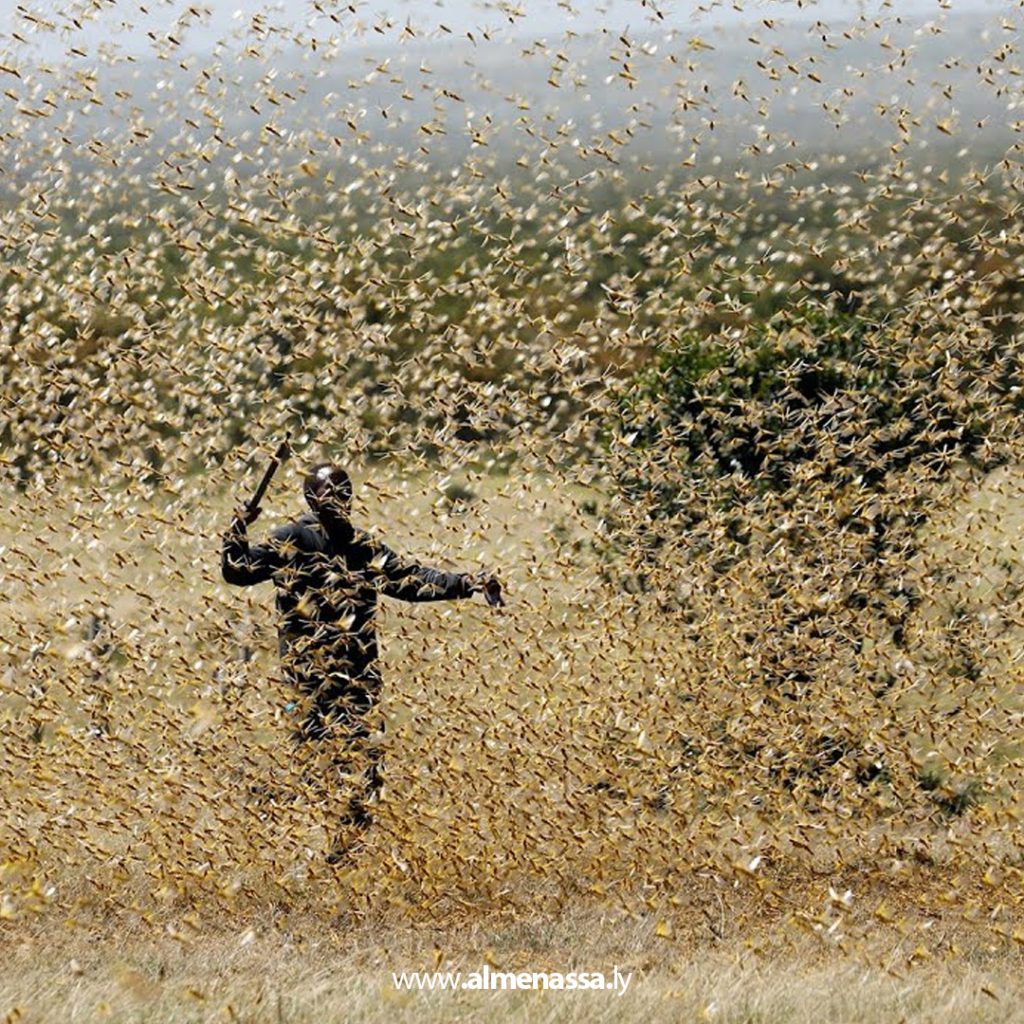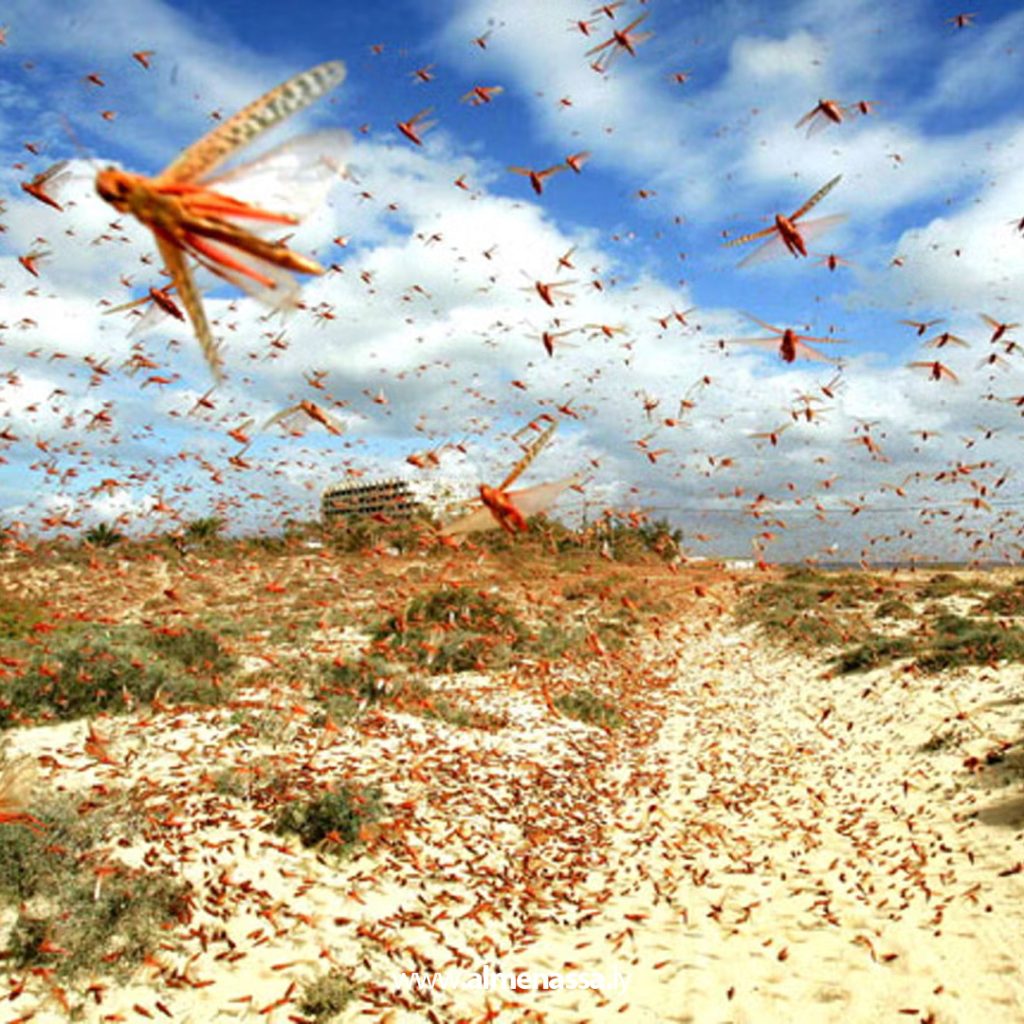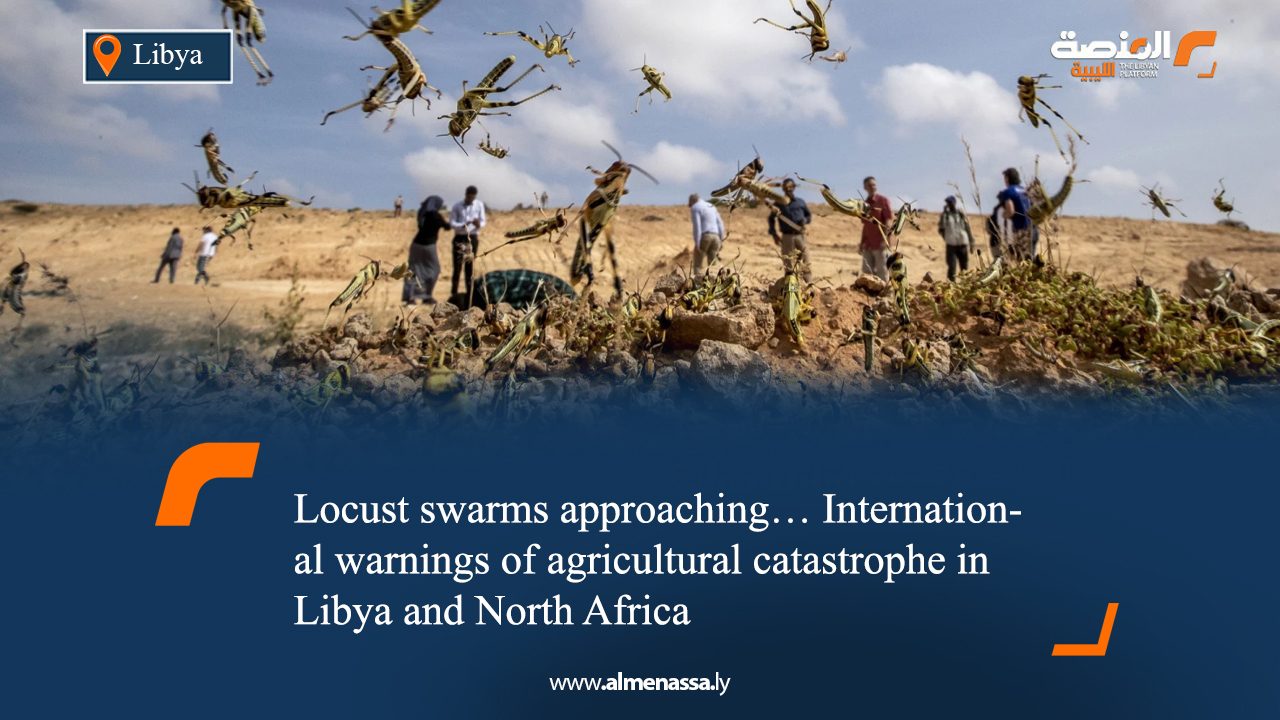The Food and Agriculture Organization of the United Nations (FAO) has warned of the continued proliferation of desert locust swarms in North Africa, particularly across Libya, Tunisia, and Algeria, throughout June and July. These warnings come amidst expectations that these swarms will move south towards the Sahel region to commence the summer breeding season.
In its monthly report issued on Friday, the organisation confirmed that adult and juvenile locust swarms continue to form in several northern areas. It indicated that summer breeding is likely to begin in southern Algeria, northern Niger, and Mauritania. The FAO also reported that spring breeding has already commenced following the arrival of locust groups in areas that received rainfall last February, especially central Algeria and western Libya.
Surveillance and movements in Libya.

Large numbers of desert locusts have been observed in various regions of Libya, most notably Tarhuna, Sebha, Tazirbu, Ghat, and Ghadames, in addition to south of Bani Walid, where nymphs developed through all their instars during May and continue to develop this June. Small mature swarms were also sighted in the northwest of the country.
Libyan authorities have initiated limited control operations, with 322 hectares of affected land treated between 1 and 18 March, to contain the spread of the destructive insect, which poses a genuine threat to crops and food security in the country.
Bani Walid, Sirte, Tarhuna, Traghen, and several southern areas experienced an intense desert locust invasion last March, as dense swarms swept through the Wadi Souf Loujin and Wadi Umm al-Dhiab regions, causing significant losses to barley crops. Mohamed Jumaa, director of the city’s vegetation cover office, stated that the swarms had reached the mating stage, indicating a potential expansion in their numbers in the coming weeks.

In the eastern oases, Brigadier Idriss Badr, head of the agricultural police, confirmed that crop damage in agricultural fields reached approximately 70%, especially in the al-Tifil areas and adjacent farms. He noted the launch of an intensive campaign in cooperation with the National Development Agency to combat the swarms.
In a related context, Libya witnessed a large wave of locust swarms last March, prompting Hussein Al-Buraiki, an official at the National Committee for Combating Desert Locusts in Libya, to warn of “an unprecedented spread of locust swarms in the south,” stressing that the country is threatened by an environmental and agricultural catastrophe unless swift measures are taken.
Al-Buraiki explained that “irregular winds contributed to the expansion of the spread,” and that “locusts entering the mating and egg-laying phase portends the emergence of new, more numerous and dangerous generations.”
He also pointed out that the lack of capabilities in a number of areas – including spraying equipment and field vehicles – severely hampers control efforts, making it difficult to contain the situation.
A research report issued by the Libyan Centre for Desert Research and Desert Communities Development also revealed that southern Libya faces “severe challenges” in combating locusts, with a sharp shortage of control equipment such as small spray tanks, pesticides, and field vehicles.
Despite efforts made by governmental bodies, including Marzouq Security Directorate, the Agricultural Police Service, and the agriculture sector, the report affirms the necessity of “unifying resources and providing urgent support” to protect farms and pastures from collapse.
Raising Concerns in neighbouring countries.

In Algeria, widespread locust swarm activity has been recorded, particularly in the wilayas of Tamanrasset, Djanet, Illizi, and In Guezzam, where vegetation remains green due to recent rains, providing a suitable environment for locust breeding. Authorities there announced the treatment of 6,523 hectares between 1 and 23 March. In Tunisia, small swarms have appeared in the southeast since mid-March.
In Tunisia, Mohamed Rajaibia, responsible for major crops at the Tunisian Union of Agriculture and Fisheries, warned of the significant risks of expanded locust spread and called for enhanced regional cooperation with Libya and Algeria.
Rajaibia affirmed that desert winds and climate change contribute to the likelihood of new swarms reaching southern Tunisia, emphasizing that his country cannot face this crisis alone, given the losses previously incurred by the agricultural sector.
In Egypt, the Ministry of Agriculture revealed the presence of 13 main bases and 52 sub-bases deployed in border areas to counter any locust proliferation.
Dr. Ahmed Rizk, head of the Central Administration for Pest Control, affirmed that the situation in Egypt is currently under control, with any emerging groups of desert locusts arriving from the country’s southern and western borders being combatted. He noted full state support and that of the Minister of Agriculture and Land Reclamation, Alaa Farouk, for control operations.
He explained that swarms are monitored through locust bases spread along the Red Sea coast from North Sinai to latitude 22 at the Sudanese border, and along the valley inland, as well as locust bases in Marsa Matrouh and the Valley.
Climatic conditions contributed to the outbreak.
The report attributed the locust outbreak to heavy rains in August and September 2024, which led to abundant vegetation cover in the northern Sahel and southern desert. These conditions persisted into winter, enabling the insects to breed outside their usual seasons.
In February and March 2025, new rains accompanied by southerly winds led to swarm movements towards new rainy areas in North Africa, resulting in the onset of active spring breeding.
Earlier, Richard Munang, a climate and Africa expert at the United Nations Environment Programme, revealed a direct link between climate change and the exacerbation of the desert locust crisis affecting the Horn of Africa since 2020, marking the worst outbreak in the region in decades.
Munang explained that unprecedented temperature increases over the past five years, in addition to heavy rains exceeding normal rates by up to 400% in late 2019, created an ideal environment for locust breeding.
He indicated that these extreme climatic phenomena, resulting from the “Indian Ocean Dipole” and exacerbated by climate change, contributed to the migration of locust swarms from desert recession areas to inhabited agricultural regions, threatening the food security of millions of people in Ethiopia, Kenya, and Somalia.
Warning of impending summer wave.
The FAO anticipates that most immature adult locusts will slowly begin moving southwest, reaching Sahelian areas by next July for summer breeding. This necessitates intensified survey and control efforts in North African and Sahelian countries to avert an imminent agricultural and economic disaster.
The report also noted that the spring breeding season in Egypt, Sudan, and Saudi Arabia is nearing its end, while it continues to a limited extent along the Pakistan-India border.
The FAO calls for an urgent regional response to prevent the crisis from escalating, by conducting regular surveys in affected areas and their surroundings, and providing the necessary resources to combat active swarms, especially in transit areas between North Africa and the Sahel, where these areas are expected to be hotbeds for new breeding during the summer season.


